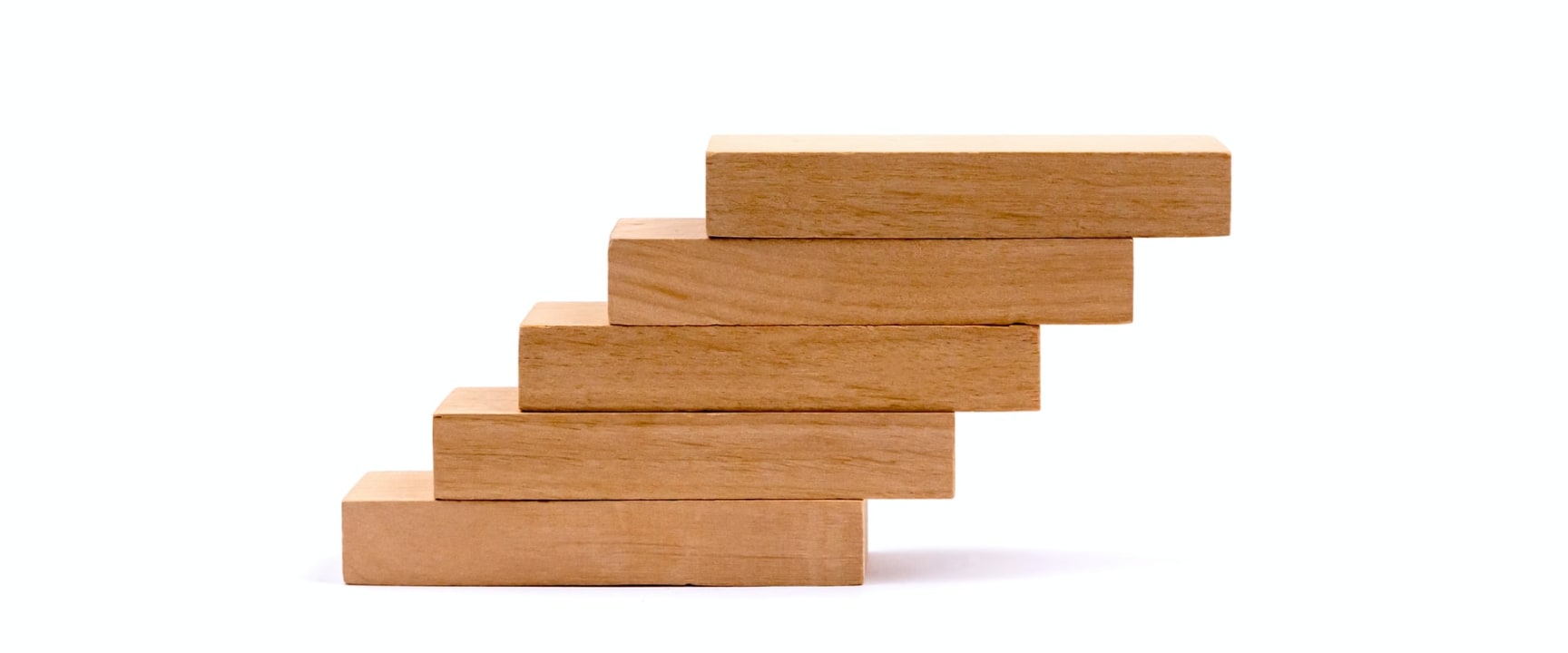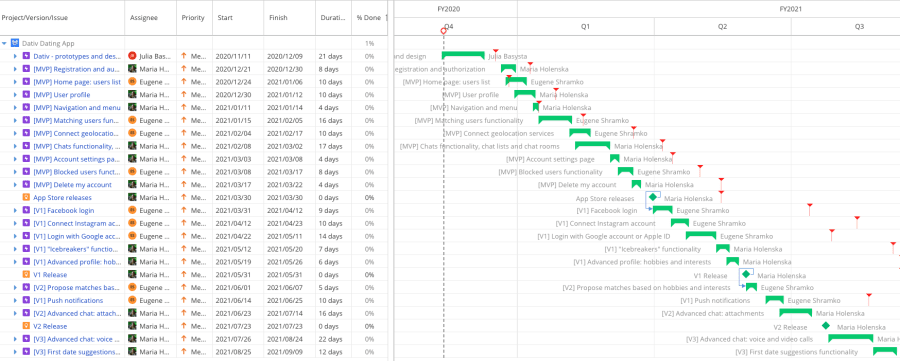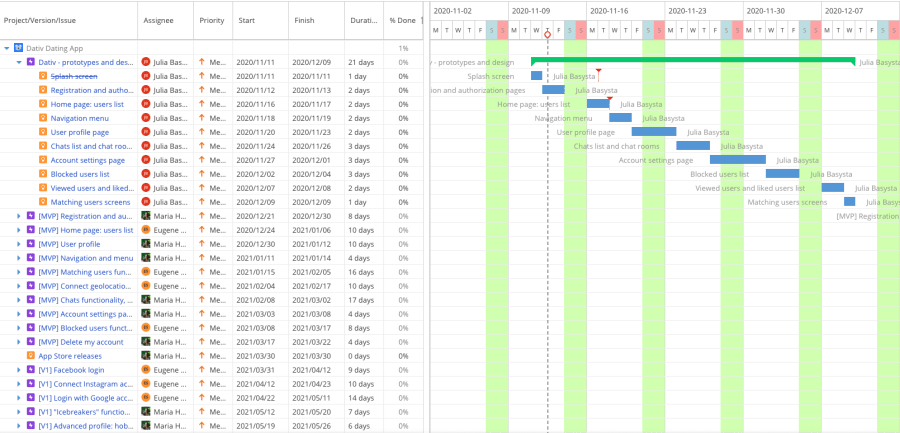NEW
Proxify is bringing transparency to tech team performance based on research conducted at Stanford. An industry first, built for engineering leaders.
Learn more
Software Engineering
App-udvikling
Nov 13, 2020 · 12 min read
How to correctly estimate your app development timeline
Willing to learn how long it will take to build your first app? Read advice from a professional project manager to accurately estimate your app development timeline.
Julia Basysta
Projektleder
Verified author
Kseniia Kyslova
Specialist i indholdsmarkedsføring
Verified author

Indholdsfortegnelse
- Don’t rely on rough app development time estimates
- Commit to a detailed app development time estimate
- Proceed to planning and get your timeline for app development
- Finish your app design before coding starts
- So, how long does it take to develop an app?
- A dating mobile app development timeline template
- Plan for time to release your app in app stores
- Ways to speed up your app development process
- Quick app development time Q&A
- How long does it take to develop an app?
- What’s the average time to develop an app?
- What are the stages of app development?
- Match med udvikler
Photo by Volodymyr Hryshchenko on Unsplash
In July 2020, there were 4.38 million apps on Apple App Store and 2.96 million apps on Google Play Store. The mobile app industry continues to rise and so does the competition on the market.
With thousands of new apps released every month, knowing your time to market is crucial. The innovative startup that launches a unique product first dominates the niche, gets optimal pricing, and yields higher revenues.
Knowing how long it takes to make your app, you’ll be able to weigh your chances of success and plan for an appropriate budget. Read on to learn how to get an accurate estimate of your time to develop an app and get pro tips from Julia Basysta, Project Manager at Proxify.io.
Don’t rely on rough app development time estimates
Using an online app development time calculator, you can get a rough estimate in three minutes. For this, you’ll choose some options from a set of basic features that the calculator offers and get them summed up.
The number you get in the calculator will most probably be misleading. That’s because such calculators don't take into account the time for preparation and planning, communication and management, possible changes in the project, and risks.
Don’t be surprised if the app development timeline announced by your app development team will be three times longer than you calculated by yourself. That’s because professional software developers take into consideration all factors that influence app development cost and time.
Be ready to spend up to 1.5 months for proper project estimation and planning. Let’s see why it may take you that long.
Boost dit team
Proxify-udviklere er et vigtigt boost af dit team, der konsekvent leverer ekspertløsninger. Vores specialister har dokumenteret erfaring fra mere end 500 brancher, så de indgår nemt i dine projekter og hjælper dig med at accelerere din køreplan med henblik på at skabe gode resultater på lang sigt.
Commit to a detailed app development time estimate
To estimate your project, you’ll need to arrange several meetings with developers and designers. You’ll need to discuss in detail all your project requirements, constraints, and acceptance criteria before you get the final project estimate. A deep understanding of your idea will help IT specialists think through your app functionalities and foresee possible pitfalls.
To figure out how long it will take to create your app, you’ll break down separate chunks of functionality into a list of small features. Then, you’ll estimate the time needed to complete tasks associated with each feature and sum it up.
Pro tip #1: ‘If you see that a single feature gets an estimate of more than 160 hours, split it into smaller ones. Dividing your project into bigger tasks raises the risk of overlooking potential technical difficulties and getting a wrong estimate.’ – Julia Basysta, Project Manager
Defining net time to build each feature on your list is not enough to make a realistic estimate. You’ll need to take into account time for quality assurance and anticipate possible delays. Those delays can be caused by the changes that may need to be done in the midst of the development process.
Pro tip #2: ‘On average, the time required for testing makes 25% of the net development time estimate. Another 30% of the overall time estimated for development and testing should be added to cover risks. It’s an absolute necessity that will allow you to handle change requests after a code review, fix the consequences of a wrong feature description, and change something after getting your first customer feedback without getting off-schedule.’ – Julia Basysta, Project Manager
As a result, you’ll get an accurate number of hours to build an app. However, those numbers rather show the scope of work to be done than the project timeline. The tasks on your list can be spread between several people and fulfilled simultaneously. This means that you need to make your staffing decisions and plan your work to see the final timeline.
Proceed to planning and get your timeline for app development
You’ll know your timeline to develop an app after you complete your project planning stage. It will take 1–2 weeks to define the exact technology stack, prepare your app specifications, and create the project plan.
When planning, you’ll break down the work into milestones. Every milestone will have the start and the end date as well as a pool of tasks to be completed during it.
Pro tip #3: ‘Spot your blockers. Those are tasks that can potentially slow down the whole project if not fulfilled on time. They’ll define the critical path for your project and allow you to determine the most efficient timeline possible.’ – Julia Basysta, Project Manager
Visualize your timeline for mobile app development in the form of a Gantt chart taking into account task overlaps. Show dependencies between blockers and the subsequent tasks that can potentially be blocked. It will help you see the parts of your development process that require special attention.
Pro tip #4: ‘When scheduling tasks, take into account weekends and upcoming holidays to set up deadlines correctly.’ – Julia Basysta, Project Manager
Ideally, after the planning stage, you’ll have a clear vision of what is going to happen during several upcoming months before the launch of your app. You’ll know what features will go into your minimum viable product (MVP) and later versions as well as their approximate release dates.
Finish your app design before coding starts
The best practice is to engage UX/UI designers at the very beginning of your app development lifecycle. You’ll need to make wireframes of your app as early as your planning stage. Wireframes will help you envision how people interact with your app and understand what features you should build.
As you continue ideating on the project, your wireframes will turn into mockups, and then into click-through prototypes. Having built a clickable prototype, you’ll be able to move through all screens that you planned. This is how you’ll check if the navigation and information architecture you’ve set up makes sense.
At the end of your planning stage, you’ll be halfway through building your app design. Therefore, finalizing it during the first stage of your app development process is the most natural thing to do.
Pro tip #5: ‘It will take you about 1 month to get your app UX and UI design ready. If your app is complex or you strive to create a truly outstanding design, it may take longer. During this time you’ll not only create the look-and-feel of your app but also refine user flows and improve the business logic of your app.’ – Julia Basysta, Project Manager
Your app prototype will be an integral part of your project documentation and requirements. Once you have it, you should present it to your developers. It’s important that they get an understanding of what your app should look like before they get to work.
So, how long does it take to develop an app?
Each case is different. Your app roadmap will depend a lot on your app scope, complexity, and the team you hire. Still, you can get an idea about your development timeline by comparing your app with an example.
A dating mobile app development timeline template
Julia Basysta has made an example development time estimate for a medium-complexity dating app. So, after the planning stage is completed, you’ll have:
- A set of features defined, prioritized, and distributed between the MVP and three subsequent versions of the app.
- A Gantt Chart built to visualize the upcoming app development process.
Dating Mobile App Long-Term Development Timeline

- All tasks decomposed, entered in the project management software with time estimates, and assigned to team members.
Dating Mobile App Timeline for a Large Feature Broken Down Into Tasks

Let’s go through the milestones of the project and calculate how long it takes to code an app like this:
App design and prototyping (1 month). Create UX / UI design for 12 types of screens.
MVP development and testing (5 months). Build the core set of app features:
- Splash screen and homepage
- Registration and authorization
- Navigation and menu
- User profile
- Matching users
- Connect geolocation services
- Chat lists and chat rooms
- Account settings
- Blocked users
- Account delete
MVP release on Google Play store/Apple App Store (0.5 months). Create an account, submit the app, and pass the review.
Buffer time after the release of MVP (0.5 months). Collect feedback from the first users.
Version 1 (2.5 months). Add advanced features:
- Facebook login
- Google account / Apple ID login
- Connect Instagram account
- Icebreaker feature
- Push notifications
- Advanced profile
Version 2 (1 month). Add advanced features:
- Matching based on interests
- Sending attachments in chat
Version 3 (1.5 months). Add advanced features:
- Voice and video calls
- First date suggestions
Let’s sup up. A dating mobile app development timeline that includes an MVP and three subsequent versions of the product makes 12 months in total.
Plan for time to release your app in app stores
The release stage of the app development lifecycle deserves special attention. Creating an account in an app store won’t take more than four hours. However, you’ll need to get your app descriptions, screenshots, icon, and demo video ready.
After you submit your app to the Google Play Store or the Apple App Store, it will have to pass moderation. As your app will be reviewed by experts manually, it may take you up to 5 business days to get approval.
A pro tip: ‘To pass the review successfully, make sure you check Google’s Developer Content Policy and App Store Review Guidelines early at your project estimation and planning stage. It will help you align your app functionality with the stores’ requirements and avoid making significant changes in your app before release.’ – Julia Basysta, Project Manager
Ways to speed up your app development process
First and foremost, to get your app to market faster, make sure that you put enough time and effort into the estimation and planning stages. Preparation is half the battle.
Cut as much upfront as possible. Your MVP should include only the most valuable and necessary features. This approach will help you stay within the average 4–6 month time to market.
Avoid making mid-project changes. Although had anticipated risks, adding or swapping features may result in deep changes in the product, extend the time needed for testing, and get your team out of schedule.
Finally, build your app with a team of highly-skilled designers and senior developers who have experience in creating similar products. As an option, consider hiring expert app developers, differing in technologies such as Flutter, iOS, Android, React Native and more.
Finding a perfect match for your project on our talent network platform will take you less than two weeks. Fast hiring takes you one step closer to the date of your app release.
If you need a time estimate for your app, reach out to get our help for free.
Quick app development time Q&A
You ask, we answer.
How long does it take to develop an app?
Your app development time will depend on its scope, complexity, and the team you hire. Yet, our example estimation shows that for 12 months you can build an MVP and three subsequent versions of a mobile dating app, like Tinder, to get a solid product.
What’s the average time to develop an app?
On average, it takes three to nine months to develop an app. For a simple project, in three months you’ll get an MVP to test the market, while in nine month you can have a solid first version of your product.
What are the stages of app development?
The app development process starts with the project estimate that culminates in the planning stage. Proper estimation and planning may take about one and a half months. The UX and UI design stage comes second and takes one more month. After the app design is ready, the coding stage begins and may take three to nine months for a simple project.
Was this article helpful?
Find din næste udvikler inden for få dage, ikke måneder
Book en 25-minutters samtale, hvor vi:
- udfører behovsafdækning med fokus på udviklingsopgaver
- Forklar vores proces, hvor vi matcher dig med kvalificerede, godkendte udviklere fra vores netværk
- beskriver de næste trin for at finde det perfekte match på få dage

